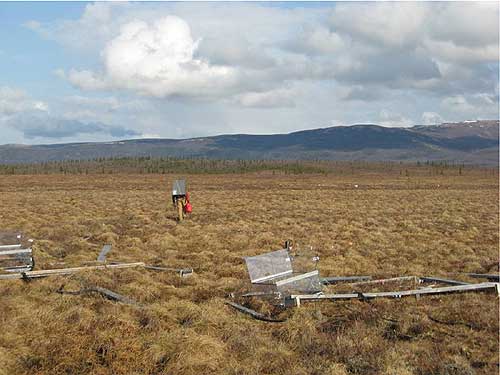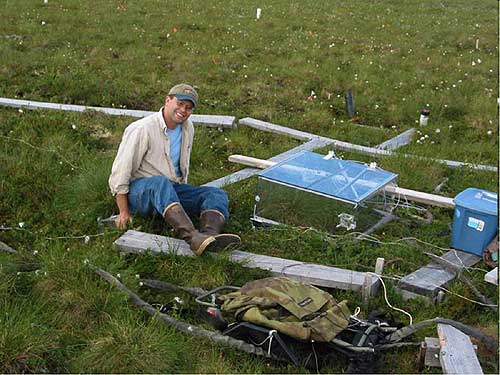 Stampede Trail has a story
of permafrost's warming potential
Stampede Trail has a story
of permafrost's warming potential
By NED ROZELL
June 12, 2009
Friday
Each fall, beginning in the early 1970s-decades before the actions
of Christopher McCandless made a gravel road in central Alaska
the setting of a bestselling book and movie - Tom Osterkamp was
driving the Stampede Trail near Healy to reach his favorite moose-hunting
areas.
In 1985, Osterkamp, a professor emeritus and permafrost researcher
with the University of Alaska Fairbanks' Geophysical Institute,
remembered a lake with a view of Denali when he was searching
for sites to study permafrost. He returned there, a few miles
up the Stampede Trail, drilled a deep borehole in the tussock
tundra near the lake, and set up a system to measure the temperature
of the ground at different depths.
Every study site is a calculated gamble, where researchers guess
from where, over time, the best information will emerge. The
spot Osterkamp chose near Eightmile Lake has turned into one
that is giving scientists insight on how thawing permafrost could
cause the world to become warmer.
 Christian Trucco walking
off the permafrost - monitoring site near Eightmile Lake off
the Stampede Trail near Healy, Alaska.
Christian Trucco walking
off the permafrost - monitoring site near Eightmile Lake off
the Stampede Trail near Healy, Alaska.
Photo by Jason Vogel.
"(It was) the first one out of more than 20 of my permafrost
observatories that showed any effects that could be associated
with the changing climate," Osterkamp said from his home
in Saint Clair, Missouri, where he has lived since retiring from
the university in 1997.
By checking temperature data every year, Osterkamp noticed by
1989 that the permafrost began to warm around Eightmile Lake.
He saw that the ground there was getting bumpy, and small pits
were beginning to form. After watching the site for several more
years, he figured the permafrost was thawing because thick blankets
of snow during the 1990s were insulating the ground from the
frigid air of winter.
"Once I realized that the permafrost was thawing naturally,
I knew it was a very important site," he said.
He shared the news of this dynamic area with UAF's Terry Chapin,
who in turn contacted Ted Schuur of the University of Florida.
Schuur who wrote a proposal and got money for a post-doctoral
scientist, Jason Vogel, to take a close look at what was happening
off Stampede Trail.
From 2004 to 2006, Vogel measured the greenhouse gas carbon dioxide
as it circulated between the atmosphere and tundra near Eightmile
Lake. The readings were telling him things so compelling that
he, Schuur, Osterkamp, and a few other scientists submitted their
results to the journal Nature, which just published them.
 Jason Vogel at the
Eightmile Lake permafrost - monitoring.
Jason Vogel at the
Eightmile Lake permafrost - monitoring.
Photo by Ted Schuur.
In the paper, the authors ponder whether faster plant growth
that results from a warmer northern landscape will take up the
carbon dioxide released by microbes as permafrost thaws.
Permafrost, ground that has remained frozen through the heat
of at least two summers, consists of a good deal of ancient plant
matter that stopped decomposing when the ground froze (in the
case of the Stampede Trail site, several thousand years ago).
As permafrost thaws, that organic matter becomes available for
tiny microorganisms to eat, who then emit carbon dioxide after
finishing their meals.
At Eightmile Lake, the early thawing that Osterkamp noticed has
stimulated tundra plants to take up more carbon dioxide than
the microbes have been giving off. But that may not be the case
in the near future, according to the scientists' calculations.
"The microbes overwhelm plants after a while," Vogel
said over the phone from Gainesville, Florida. "It'll take
a very small amount of additional thawing (for that to happen
at the Stampede Trail site). Plants have an
upper limit to their potential photosynthesis; microbes are more
limited by the amount of available carbon. So, once carbon in
the soil becomes available (unfrozen), they become more and more
active."
With the microbes going crazy, areas of former permafrost like
the tundra near Eightmile Lake could become a new source of carbon
dioxide in the air. Should the big thaw continue, the tundra
of Alaska, Canada, and Siberia could release as much locked-up
carbon as does the current deforestation of the tropics, the
researchers said.
This column is provided
as a public service by the Geophysical
Institute,
University of Alaska Fairbanks, in cooperation with the UAF
research community.
Ned Rozell [nrozell@gi.alaska.edu]
is a science writer at the institute.
E-mail your news &
photos to editor@sitnews.us
Publish A Letter in SitNews Read Letters/Opinions
Contact the Editor
SitNews
©2009
Stories In The News
Ketchikan, Alaska
|


